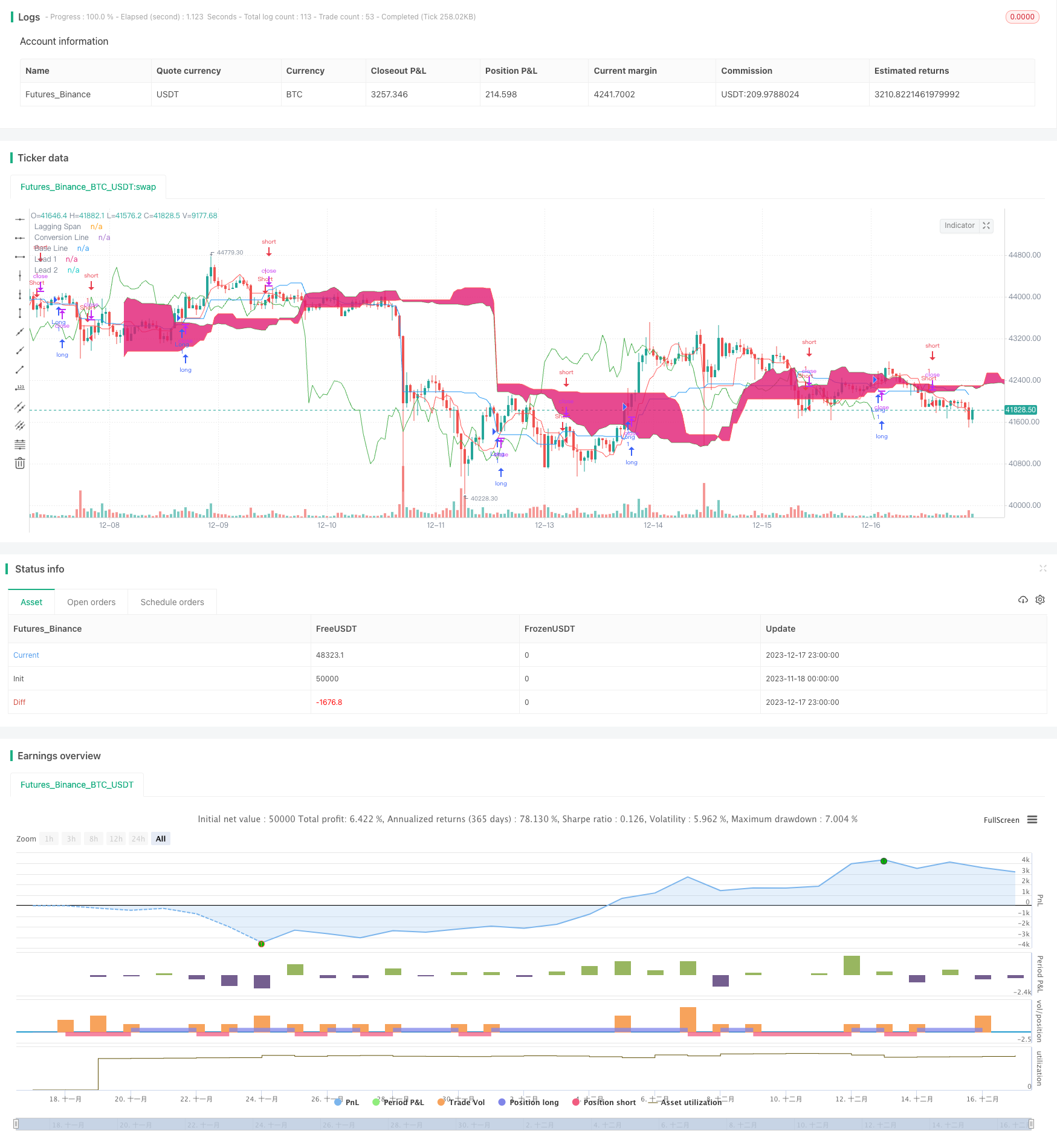
概述
Ichimoku均线交叉策略通过计算一系列均线,识别股价交叉信号,进行长短做多做空操作。该策略结合多种技术指标,扎实可靠,适用于中长线操作。
策略原理
Ichimoku均线交叉策略使用一份由5条均线组成的专门指标体系。具体来说,包含换手线、基准线、先行1、先行2和延迟线5条均线。其中,换手线是近期价格动量的均线,基准线反映中长期价格趋势,先行线组合换手线和基准线,反映未来走势,延迟线显示过去价格的参考。当价格突破基准线时产生交易信号。该策略同时结合实体线滤波器和K线色彩判断,避免假突破。
策略优势
Ichimoku均线交叉策略集多种技术指标优点于一体。它融合了移动平均线、价格通道、量价确认等多个策略思想,形成系统性的方法论体系。这保证了交易信号的 accurateness和方向性。与单一指标策略相比,该策略可以大大降低假信号的概率,提高盈利因子。
策略风险
Ichimoku均线交叉策略作为趋势跟随策略,其交易Interval较长。这意味着策略无法捕捉短期价格震荡。此外,股价剧烈波动时,均线指标会失效。这些情况下,会产生错误信号和亏损交易。建议采用止损来控制风险。
优化方向
Ichimoku均线交叉策略可以从以下方向进行优化:1)调整均线参数,适应不同周期和品种;2)结合量能指标,确认价格和交易量关系;3)引入机器学习模型,改进信号判断;4)加入更多条件和过滤器,降低错误交易发生概率。
总结
Ichimoku均线交叉策略稳定可靠,适合作为核心策略,与其他算法组合使用。它提供清晰的趋势交易方向,而参数调整和多指标优化又使策略更加智能和灵活。该策略值得量化交易者重点研究和长期应用。
策略源码
/*backtest
start: 2023-11-18 00:00:00
end: 2023-12-18 00:00:00
period: 1h
basePeriod: 15m
exchanges: [{"eid":"Futures_Binance","currency":"BTC_USDT"}]
*/
//Noro
//2018
//@version=3
strategy(title = "Noro's Ichimoku Strategy v1.0", shorttitle = "Ichimoku str 1.0", overlay = true, default_qty_type = strategy.percent_of_equity, default_qty_value = 100, pyramiding = 0)
//Settings
needlong = input(true, defval = true, title = "Long")
needshort = input(true, defval = true, title = "Short")
conversionPeriods = input(9, minval = 1, title = "Conversion Periods")
basePeriods = input(26, minval = 1, title = "Base Periods")
laggingSpan2Periods = input(52, minval = 1, title = "Lagging Span")
usebf = input(true, defval = true, title = "Use body filter")
usecf = input(true, defval = true, title = "Use color filter")
fromyear = input(1900, defval = 1900, minval = 1900, maxval = 2100, title = "From Year")
toyear = input(2100, defval = 2100, minval = 1900, maxval = 2100, title = "To Year")
frommonth = input(01, defval = 01, minval = 01, maxval = 12, title = "From Month")
tomonth = input(12, defval = 12, minval = 01, maxval = 12, title = "To Month")
fromday = input(01, defval = 01, minval = 01, maxval = 31, title = "From day")
today = input(31, defval = 31, minval = 01, maxval = 31, title = "To day")
//Ichimoku
donchian(len) => avg(lowest(len), highest(len))
conversionLine = donchian(conversionPeriods)
baseLine = donchian(basePeriods)
leadLine1 = avg(conversionLine, baseLine)
leadLine2 = donchian(laggingSpan2Periods)
//Lines
plot(conversionLine, color=red, title="Conversion Line")
plot(baseLine, color=blue, title="Base Line")
plot(close, offset = -basePeriods, color=green, title="Lagging Span")
p1 = plot(leadLine1, offset = basePeriods, color=green, title="Lead 1")
p2 = plot(leadLine2, offset = basePeriods, color=red, title="Lead 2")
fill(p1, p2)
//Body Filter
nbody = abs(close - open)
abody = sma(nbody, 10)
body = nbody > abody / 3 or usebf == false
//Color Filter
bar = close > open ? 1 : close < open ? -1 : 0
gb = bar == 1 or usecf == false
rb = bar == -1 or usecf == false
//Signals
up = low > baseLine and rb and body
dn = high < baseLine and gb and body
//Trading
if up
//if strategy.position_size < 0
// strategy.close_all()
strategy.entry("Long", strategy.long, needlong == false ? 0 : na, when=(time > timestamp(fromyear, frommonth, fromday, 00, 00) and time < timestamp(toyear, tomonth, today, 23, 59)))
if dn
//if strategy.position_size > 0
// strategy.close_all()
strategy.entry("Short", strategy.short, needshort == false ? 0 : na, when=(time > timestamp(fromyear, frommonth, fromday, 00, 00) and time < timestamp(toyear, tomonth, today, 23, 59)))
if time > timestamp(toyear, tomonth, today, 23, 59)
strategy.close_all()